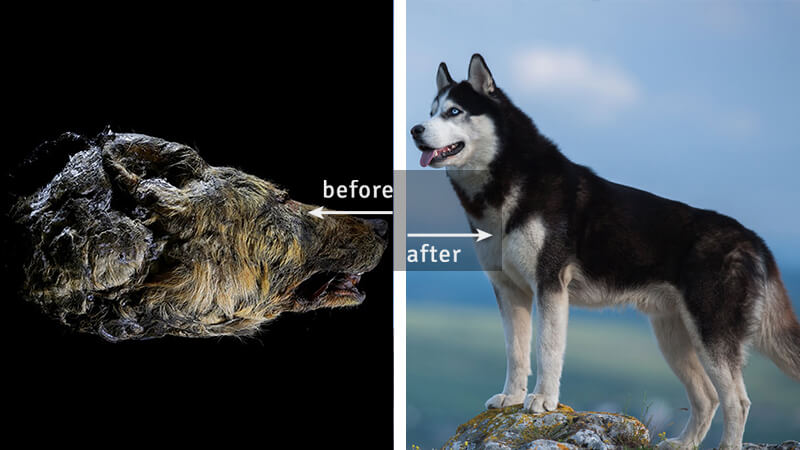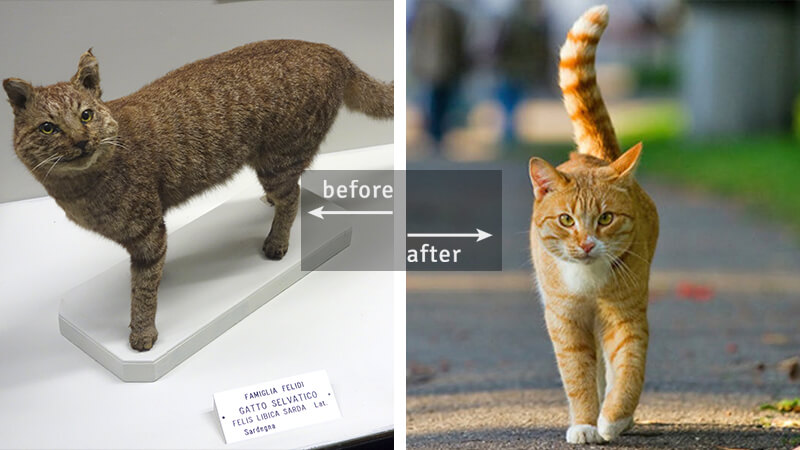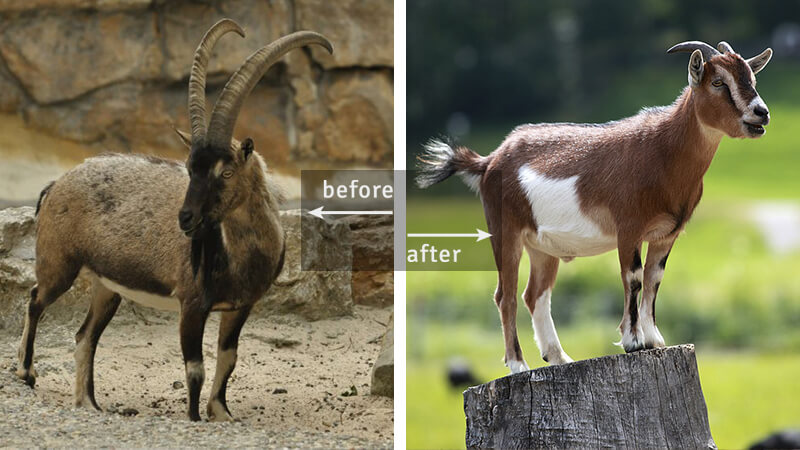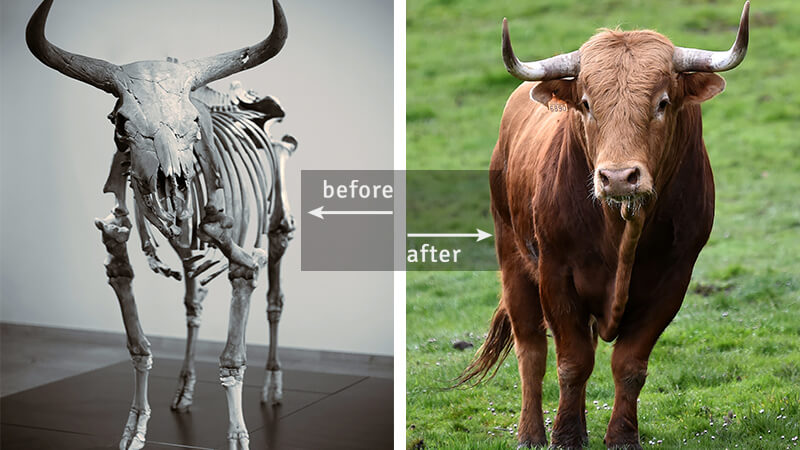6 Wild and Prehistoric Ancestors of Today’s Domestic Animals
1. Wild and Prehistoric Ancestors of Today’s Domestic Animals
before
The megafaunal wolf (Canis cf. lupus) was a Late Pleistocene – early Holocene hypercarnivore similar in size to a large extant gray wolf. It had a shorter, broader palate with large carnassial teeth relative to its overall skull size. This adaptation allowed it to prey and scavenge on Pleistocene megafauna. Such an adaptation is an example of phenotypic plasticity. It was once distributed across the northern Holarctic.

after
The origin of the domestic dog (Canis lupus familiaris) includes the dog’s genetic divergence from the wolf, its domestication, and the emergence of the first dogs. Genetic studies show that all ancient and modern dogs share a common ancestry and descended from an ancient, now-extinct wolf population – or closely related wolf populations – which was distinct from the modern wolf lineage. The dog’s similarity to the extant grey wolf is the result of substantial dog-into-wolf gene flow, with the modern grey wolf being the dog’s nearest living relative. An extinct Late Pleistocene wolf may have been the ancestor of the dog, with one study proposing that this Pleistocene wolf was closer in size to a village dog.
2․ Felis silvestris lybica / Cat
before
According to a recent study by Claudio Ottoni, cat domestication took place in two strains, but all domestic cats have a common ancestor: the North African / Southwest Asian wildcat, Felis silvestris lybica (Ottoni and others 2017). By studying ancient cat DNA from all over the world, the researchers found that cat domestication began in the Fertile Crescent (in the Neolithic period) and accelerated later in ancient Egypt (in the Classical period) (Ottoni and others 2017).

after
The domestic cat (Felis catus) is one of the most recently evolved species within the Felidae family. A comprehensive survey of cat genes suggests that even after felines wandered into our lives, they remained largely unchanged for thousands of years. As of 2021 there are an estimated 220 million owned and 480 million stray cats in the world. As of 2017, the domestic cat was the second-most popular pet in the United States, with 95 million cats owned. In the United Kingdom, around 7.3 million cats lived in more than 4.8 million households as of 2019.
3․ Bezoar ibex / Goat
before
The bezoar ibex (Capra aegagrus aegagrus), also known as the Anatolian bezoar ibex, Persian ibex, or (by Anatolian locals) dağ keçisi (Turkish: ‘mountain goat’), is a wild goat subspecies that is native to montane forests from Turkey to Iran. The bezoar ibex, if not the sole progenitor of the modern domestic goat, is at least its main progenitor. The archaeological evidence traces goat domestication as far back as c. 10,500 years Before Present, and DNA evidence suggests 10,000 years BP.

after
The domestic goat or simply goat (Capra aegagrus hircus) is a subspecies of C. aegagrus domesticated from the wild goat of Southwest Asia and Eastern Europe. Goats are among the earliest animals domesticated by humans. The most recent genetic analysis confirms the archaeological evidence that the wild bezoar ibex of the Zagros Mountains is the likely original ancestor of probably all domestic goats today.
4. Wild boar / Pig
before
The ancestor of the domestic pig (Sus scrofa domesticus) is the wild boar, which is one of the most numerous and widespread large mammals. Archaeological evidence suggests that pigs were domesticated from wild boar as early as 13,000–12,700 BCE in the Near East in the Tigris Basin. Its many subspecies are native to all but the harshest climates of continental Eurasia and its islands and Africa as well, from Ireland and India to Japan and north to Siberia.

after
With around 1 billion individuals alive at any time, the domestic pig (Sus scrofa domesticus) is one of the most numerous large mammals on the planet. Pigs are omnivores and can consume a wide range of food. Pigs are biologically similar to humans and are thus frequently used for human medical research.
5. Armenian mouflon / Sheep
before
The Armenian mouflon (Ovis gmelini gmelini) is an endangered subspecies of mouflon endemic to Iran, Armenia, and Nakhchivan (Azerbaijan). In Armenia, mouflon is found in Syunik Province (and to a lesser extent, in the provinces of Ararat and Vayots Dzor). According to a 2009 study there were “hardly over 200” mouflons in Armenia. In Azerbaijan, an estimated 250 to 300 mouflons are found in the Nakhchivan Autonomous Republic.

after
The exact line of descent between domestic sheep (Ovis aries) and their wild ancestors is unclear. The most common hypothesis states that Ovis aries is descended from the Asiatic (O. orientalis) species of mouflon – Armenian mouflon (Ovis gmelini gmelini). Sheep were among the first animals to be domesticated by humans; the domestication date is estimated to fall between 11,000 and 8,000 B.C in Mesopotamia.
6. Aurochs / Cattle
before
The aurochs (Bos primigenius), also known as urus or ure, is an extinct species of large wild cattle that inhabited Asia, Europe, and North Africa. It is the ancestor of domestic cattle. The species survived in Europe until 1627, when the last recorded aurochs died in the Jaktorów Forest, Poland.
During the Neolithic Revolution, which occurred during the early Holocene, at least two aurochs domestication events occurred: one related to the Indian subspecies, leading to zebu cattle, and the other related to the Eurasian subspecies, leading to taurine cattle. Other species of wild bovines were also domesticated, namely the wild water buffalo, gaur, wild yak, and banteng.

after
Cattle, or cows (female) and bulls (male), are the most common type of large domesticated ungulates. They are a prominent modern member of the subfamily Bovinae, are the most widespread species of the genus Bos, and are most commonly classified collectively as Bos taurus.
Around 10,500 years ago, cattle were domesticated from as few as 80 progenitors in central Anatolia, the Levant and Western Iran. According to the Food and Agriculture Organization (FAO), there are approximately 1.5 billion cattle in the world as of 2018. In 2009, cattle became one of the first livestock animals to have a fully mapped genome.
Source: Wikipedia, National Geographic




